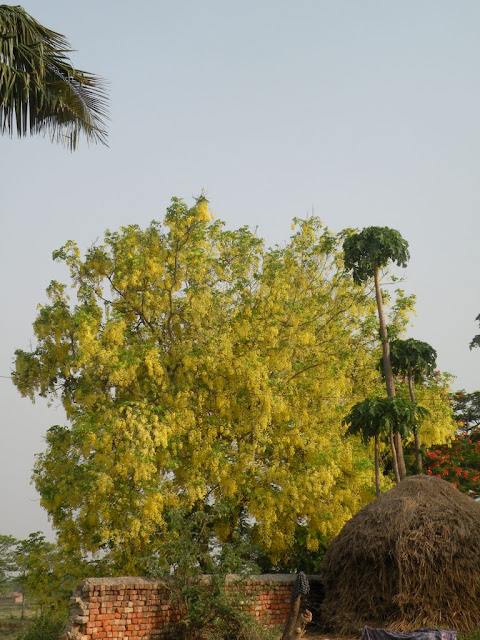Pictures and Story By Manju Rana
These are the images I took when I visited Aurahi last week, when daytime temperatures were hovering in the mid-40s. I saw work going on nearly a war footing to build temporary toilets in the village, the distribution of relief supplies, and also observed how the men and women (and in some cases animals too) in Aurahi were trying to get back to normalcy. It is difficult though.
First the process of building toilets.Ultimately 80 common toilets will be constructed in the fire ravaged areas. When i was in Aurahi the sample toilet was nearing completion, and was told that by 13th June first 10 latrines would be completed.
As I went around I saw all the activities going on for building these toilets. In one corner of the village, workers were busy making concrete rings for the toilet/latrine pit. These are the dyes to cast concrete to make the rings.
These are rings that already out of the cast and drying in the sun.
This is a double pit latrine, where the pan has already been set. This toilet / latrine is going to be built as the sample for all the villagers to see, and is located very close to the distribution site for relief materials.
Experts, including UNICEF WASH Specialist Madhav Pahari (in white cap) inspect the latrine
Nearby there was an old man who was using his skills to make the bamboo walls for the temporary toilets.
He was slicing the bamboo into thin slats for the walls
The walls go up
The pits are then covered by concrete slabs and pipes also fitted
The bamboo is then covered by black polethene sheeting. This is the door
The sample latrine is now complete. I was told that the other toilets in the village will be raised even more, in view of possible flooding during monsoon, which is right around the corner

During our stay there the consignment of buckets arrived.
These buckets are being distributed so that people can use it to store and purify water, amongst other things. They were distributed following verification of their ID/ration cards
While we were there UNICEF team members including the Deputy Representative and the Chief of the Eastern Region Field Office came to Aurahi to take stock of the relief efforts. Here they are interacting with the Relief Distribution Community members
As I walked around the village I could still signs of how devastating the fire was. Below is a pile of assets turned to ashes
It was not just houses that were burnt.. even vegetation was not spared. A local told me that it took less than 50 minutes to turn a thriving village to smoking ruins
Although there were no human casualties in the fire, I saw several livestock with severe burns.
Most of the villagers are trying to make the best of out of the relief materials they have been provided. Blue tarpaulins can be seen everywhere
Meanwhile temporary shelter (huts) with tin roofing have also started being built with the support from the various agencies including technical support from Habitat for Humanity. At least that will keep them safe from rain as well as future fires
And life goes on. Amna Khatun delivered a baby boy three days earlier at the birthing centre. Since her house was also burnt down, she is now living with her husband’s relatives.
Nearby there are mango groves that escaped the fire.. nearing harvest time
And very close to it, this Laburnum tree in full bloom.. full of a promises of a brighter future.
Manju is Senior Communication Assistant in UNICEF Nepal.
She can be reached at manrana@unicef.org
She can be reached at manrana@unicef.org
Once dry, the 'thirsty' rings needed to be ‘watered’ frequently to make them stronger

























































